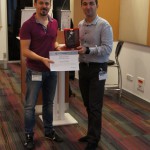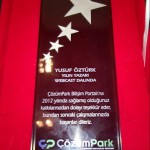
Categories

Sponsors


Archive
 Blogroll

Badges


Community

|
Posted in Virtual Machine Manager, Windows Powershell, Windows Server | No Comment | 1,347 views | 30/09/2013 15:44
You can get VMs with vHBA on Hyper-V Cluster via this PowerShell script:
Get-Cluster | Get-ClusterNode | % {Get-VM -ComputerName $_.Name | Where {(($_ | Select -expand FibreChannelHostBusAdapters) -ne $Null)}} | ft Name, ComputerName, State |
Get-Cluster | Get-ClusterNode | % {Get-VM -ComputerName $_.Name | Where {(($_ | Select -expand FibreChannelHostBusAdapters) -ne $Null)}} | ft Name, ComputerName, State You should run your PowerShell as Administrator.

Posted in Virtual Machine Manager, Windows Powershell, Windows Server | No Comment | 1,407 views | 30/09/2013 15:17
You should run this script on Cluster node. Migrates all VM online.
1
2
3
4
5
6
7
8
9
10
11
12
13
14
15
16
17
18
19
20
21
22
23
24
25
26
27
28
29
30
31
32
33
34
35
36
37
38
39
40
41
42
43
44
45
46
47
48
49
50
51
52
53
54
| # Configuration
$DestinationCluster = "cluster.domain.com"
# Get Host and Cluster Information
$Hostname = (Get-VMHost).Name
$SourceCluster = (Get-Cluster $Hostname).Name
# Create VM Array
$VMArray = New-Object System.Collections.ArrayList
$VMArray.Clear();
# Get VMs and Add to VM Array
$VMs = Get-VM | Where {(($_ | Select -Expand HardDrives).Path -like "Disk*") -or (($_ | Select -expand FibreChannelHostBusAdapters) -ne $Null)}
$AddArray = $VMs | % {$VMArray.Add($_.Name)}
# Get All Virtual Machines
$AllVMs = Get-VM
foreach ($VM in $AllVMs)
{
# Get VM and Cluster Information
$VMName = $VM.Name
$HyperVHost = $VM.ComputerName
$VMState = $VM.State
$ClusterGroup = Get-ClusterGroup | where Name -like "*$VMName*"
if ($VMArray.Contains($VMName) -eq $False)
{
# Remove from Cluster Resources
if ($ClusterGroup)
{
Get-ClusterGroup $ClusterGroup.Name -Cluster $SourceCluster | Remove-ClusterGroup -RemoveResources -Force
}
Write-Host " "
Write-Host Working on $VMName ..
# Get Volume and Memory Information
$Volume = ((Get-ClusterSharedVolume -Cluster $DestinationCluster | Select -ExpandProperty SharedVolumeInfo | Select @{label="Name";expression={(($_.FriendlyVolumeName).Split("\"))[-1]}},@{label="FreeSpace";expression={($_ | Select -Expand Partition).FreeSpace}} | Sort FreeSpace -Descending)[0]).Name
$DestinationNode = ((Get-Cluster $DestinationCluster | Get-ClusterNode | Select Name,@{label="FreeMemory";expression={([math]::round(((Get-WmiObject -ComputerName $_.Name -Class Win32_OperatingSystem).FreePhysicalMemory / 1KB), 0))}} | Sort FreeMemory -Descending)[0]).Name
# Move Virtual Machine
Move-VM $VMName -ComputerName $HyperVHost -DestinationHost $DestinationNode -IncludeStorage -DestinationStoragePath C:\ClusterStorage\$Volume\$VMName
# Add to Destination Cluster Resources
Add-VMToCluster $VMName -Cluster $DestinationCluster
Write-Host Done.
}
else
{
Write-Host " "
Write-Host Skipping $VMName ..
}
} |
# Configuration
$DestinationCluster = "cluster.domain.com"
# Get Host and Cluster Information
$Hostname = (Get-VMHost).Name
$SourceCluster = (Get-Cluster $Hostname).Name
# Create VM Array
$VMArray = New-Object System.Collections.ArrayList
$VMArray.Clear();
# Get VMs and Add to VM Array
$VMs = Get-VM | Where {(($_ | Select -Expand HardDrives).Path -like "Disk*") -or (($_ | Select -expand FibreChannelHostBusAdapters) -ne $Null)}
$AddArray = $VMs | % {$VMArray.Add($_.Name)}
# Get All Virtual Machines
$AllVMs = Get-VM
foreach ($VM in $AllVMs)
{
# Get VM and Cluster Information
$VMName = $VM.Name
$HyperVHost = $VM.ComputerName
$VMState = $VM.State
$ClusterGroup = Get-ClusterGroup | where Name -like "*$VMName*"
if ($VMArray.Contains($VMName) -eq $False)
{
# Remove from Cluster Resources
if ($ClusterGroup)
{
Get-ClusterGroup $ClusterGroup.Name -Cluster $SourceCluster | Remove-ClusterGroup -RemoveResources -Force
}
Write-Host " "
Write-Host Working on $VMName ..
# Get Volume and Memory Information
$Volume = ((Get-ClusterSharedVolume -Cluster $DestinationCluster | Select -ExpandProperty SharedVolumeInfo | Select @{label="Name";expression={(($_.FriendlyVolumeName).Split("\"))[-1]}},@{label="FreeSpace";expression={($_ | Select -Expand Partition).FreeSpace}} | Sort FreeSpace -Descending)[0]).Name
$DestinationNode = ((Get-Cluster $DestinationCluster | Get-ClusterNode | Select Name,@{label="FreeMemory";expression={([math]::round(((Get-WmiObject -ComputerName $_.Name -Class Win32_OperatingSystem).FreePhysicalMemory / 1KB), 0))}} | Sort FreeMemory -Descending)[0]).Name
# Move Virtual Machine
Move-VM $VMName -ComputerName $HyperVHost -DestinationHost $DestinationNode -IncludeStorage -DestinationStoragePath C:\ClusterStorage\$Volume\$VMName
# Add to Destination Cluster Resources
Add-VMToCluster $VMName -Cluster $DestinationCluster
Write-Host Done.
}
else
{
Write-Host " "
Write-Host Skipping $VMName ..
}
} After migration, VM will be started on destination host.

Posted in Virtual Machine Manager, Windows Powershell, Windows Server | No Comment | 1,593 views | 30/09/2013 15:15
You should run this script on Cluster node. Migrates all VM by shutting down first.
1
2
3
4
5
6
7
8
9
10
11
12
13
14
15
16
17
18
19
20
21
22
23
24
25
26
27
28
29
30
31
32
33
34
35
36
37
38
39
40
41
42
43
44
45
46
47
48
49
50
51
52
53
54
55
56
57
58
59
60
61
62
63
64
65
66
| # Configuration
$DestinationCluster = "cluster.domain.com"
# Get Host and Cluster Information
$Hostname = (Get-VMHost).Name
$SourceCluster = (Get-Cluster $Hostname).Name
# Create VM Array
$VMArray = New-Object System.Collections.ArrayList
$VMArray.Clear();
# Get VMs and Add to VM Array
$VMs = Get-VM | Where {(($_ | Select -Expand HardDrives).Path -like "Disk*") -or (($_ | Select -expand FibreChannelHostBusAdapters) -ne $Null)}
$AddArray = $VMs | % {$VMArray.Add($_.Name)}
# Get All Virtual Machines
$AllVMs = Get-VM
foreach ($VM in $AllVMs)
{
# Get VM and Cluster Information
$VMName = $VM.Name
$HyperVHost = $VM.ComputerName
$VMState = $VM.State
$ClusterGroup = Get-ClusterGroup | where Name -like "*$VMName*"
if ($VMArray.Contains($VMName) -eq $False)
{
# Remove from Cluster Resources
if ($ClusterGroup)
{
Get-ClusterGroup $ClusterGroup.Name -Cluster $SourceCluster | Remove-ClusterGroup -RemoveResources -Force
}
Write-Host " "
Write-Host Working on $VMName ..
# Get Volume and Memory Information
$Volume = ((Get-ClusterSharedVolume -Cluster $DestinationCluster | Select -ExpandProperty SharedVolumeInfo | Select @{label="Name";expression={(($_.FriendlyVolumeName).Split("\"))[-1]}},@{label="FreeSpace";expression={($_ | Select -Expand Partition).FreeSpace}} | Sort FreeSpace -Descending)[0]).Name
$DestinationNode = ((Get-Cluster $DestinationCluster | Get-ClusterNode | Select Name,@{label="FreeMemory";expression={([math]::round(((Get-WmiObject -ComputerName $_.Name -Class Win32_OperatingSystem).FreePhysicalMemory / 1KB), 0))}} | Sort FreeMemory -Descending)[0]).Name
# Stop Virtual Machine
if ($VMState -ne "Off")
{
Stop-VM $VMName -Force
}
# Move Virtual Machine
Move-VM $VMName -ComputerName $HyperVHost -DestinationHost $DestinationNode -IncludeStorage -DestinationStoragePath C:\ClusterStorage\$Volume\$VMName
# Add to Destination Cluster Resources
Add-VMToCluster $VMName -Cluster $DestinationCluster
# Start Virtual Machine
if ($VMState -ne "Off")
{
Start-VM $VMName -ComputerName $DestinationNode
}
Write-Host Done.
}
else
{
Write-Host " "
Write-Host Skipping $VMName ..
}
} |
# Configuration
$DestinationCluster = "cluster.domain.com"
# Get Host and Cluster Information
$Hostname = (Get-VMHost).Name
$SourceCluster = (Get-Cluster $Hostname).Name
# Create VM Array
$VMArray = New-Object System.Collections.ArrayList
$VMArray.Clear();
# Get VMs and Add to VM Array
$VMs = Get-VM | Where {(($_ | Select -Expand HardDrives).Path -like "Disk*") -or (($_ | Select -expand FibreChannelHostBusAdapters) -ne $Null)}
$AddArray = $VMs | % {$VMArray.Add($_.Name)}
# Get All Virtual Machines
$AllVMs = Get-VM
foreach ($VM in $AllVMs)
{
# Get VM and Cluster Information
$VMName = $VM.Name
$HyperVHost = $VM.ComputerName
$VMState = $VM.State
$ClusterGroup = Get-ClusterGroup | where Name -like "*$VMName*"
if ($VMArray.Contains($VMName) -eq $False)
{
# Remove from Cluster Resources
if ($ClusterGroup)
{
Get-ClusterGroup $ClusterGroup.Name -Cluster $SourceCluster | Remove-ClusterGroup -RemoveResources -Force
}
Write-Host " "
Write-Host Working on $VMName ..
# Get Volume and Memory Information
$Volume = ((Get-ClusterSharedVolume -Cluster $DestinationCluster | Select -ExpandProperty SharedVolumeInfo | Select @{label="Name";expression={(($_.FriendlyVolumeName).Split("\"))[-1]}},@{label="FreeSpace";expression={($_ | Select -Expand Partition).FreeSpace}} | Sort FreeSpace -Descending)[0]).Name
$DestinationNode = ((Get-Cluster $DestinationCluster | Get-ClusterNode | Select Name,@{label="FreeMemory";expression={([math]::round(((Get-WmiObject -ComputerName $_.Name -Class Win32_OperatingSystem).FreePhysicalMemory / 1KB), 0))}} | Sort FreeMemory -Descending)[0]).Name
# Stop Virtual Machine
if ($VMState -ne "Off")
{
Stop-VM $VMName -Force
}
# Move Virtual Machine
Move-VM $VMName -ComputerName $HyperVHost -DestinationHost $DestinationNode -IncludeStorage -DestinationStoragePath C:\ClusterStorage\$Volume\$VMName
# Add to Destination Cluster Resources
Add-VMToCluster $VMName -Cluster $DestinationCluster
# Start Virtual Machine
if ($VMState -ne "Off")
{
Start-VM $VMName -ComputerName $DestinationNode
}
Write-Host Done.
}
else
{
Write-Host " "
Write-Host Skipping $VMName ..
}
} After migration, VM will be started on destination host.

Posted in Windows Powershell, Windows Server | No Comment | 2,011 views | 27/09/2013 15:50
You can get VMs with Passthrough disks and vHBA on Hyper-V Cluster via this PowerShell script:
Get-Cluster | Get-ClusterNode | % {Get-VM -ComputerName $_.Name | Where {(($_ | Select -Expand HardDrives).Path -like "Disk*") -or (($_ | Select -expand FibreChannelHostBusAdapters) -ne $Null)}} |
Get-Cluster | Get-ClusterNode | % {Get-VM -ComputerName $_.Name | Where {(($_ | Select -Expand HardDrives).Path -like "Disk*") -or (($_ | Select -expand FibreChannelHostBusAdapters) -ne $Null)}} You should run your PowerShell as Administrator.

Posted in Hayattan | No Comment | 1,860 views | 27/09/2013 10:57
Sonunda bir hayattan.. yazısı daha. Bu aralar iş yoğunluğu nedeniyle artık blogta sosyal hayattan paylaşımlar yapamayacak duruma gelmiştim. Bunda belki biraz da Facebook’un çok daha basit bir paylaşım platformu olması ve bloguma oranla çok daha fazla kişiye hızlı bir şekilde ulaşıyor olmasından da kaynaklanıyor olabilir :) Bu durum da blogumda daha çok PowerShell içerikli scriptlerin eklenmesine sebep oluyordu :) Fakat uzun bir aradan sonra tekrar bana ait bir blog yazısıyla buradayım. Son “hayattan” kategorisindeki yazımı, 11 Kasım 2012’de Londra notlarım olarak eklemişim. Yeni yazı ile birlikte de sosyal paylaşımlarımı sürdürmeye karar verdim :)
15 Eylül’de yapılan ÇözümPark yazar toplantısında, Webcast dalında yılın yazarı seçildiğim söylenerek güzel bir sürprizle karşılaştım :) Sağolsunlar güzel bir plaket ve sertifika ile taçlandırmışlar bu güzel ödülü. Çok onurlandım ve duygulandım :) Microsoft Türkiye’de gerçekleşen harika etkinlikten bana kalan (süper bir hediye, plaket ve sertifika dışında :)) aşağıdaki güzel kareler oldu :)
Yılın yazarı hediyesi olarak verilen süper cihazı ise burada paylaşmıyorum :) Sonuçta plaket ve sertifikanın benim için değeri çok daha fazlaydı :)

Posted in Windows Powershell, Windows Server | No Comment | 1,994 views | 27/09/2013 10:11
You can get WWN information from servers like this:
1
2
3
4
5
6
7
| $Servers = "VMHOST01","VMHOST02","VMHOST03","VMHOST04"
Foreach ($Server in $Servers)
{
Write-Host $Server
Invoke-Command -ComputerName $Server -ScriptBlock {&C:\StorageTools\fcinfo\fcinfo}
Write-Host " "
} |
$Servers = "VMHOST01","VMHOST02","VMHOST03","VMHOST04"
Foreach ($Server in $Servers)
{
Write-Host $Server
Invoke-Command -ComputerName $Server -ScriptBlock {&C:\StorageTools\fcinfo\fcinfo}
Write-Host " "
} You must deploy fcinfo.exe to hosts before you execute this script. You may also use WMI to get WWNs.

Posted in Windows Powershell, Windows Server | 2 Comments | 7,671 views | 24/09/2013 10:47
There are some disk operations you can do in Windows Server 2008 R2 with PowerShell:
1
2
3
4
5
6
7
8
9
10
11
12
13
14
15
16
17
18
19
20
21
22
23
24
25
26
27
28
29
| # Getting Disk Signature
Get-WmiObject Win32_DiskDrive | ft Name, Signature, Index
# Add Disk Signatures into Array
$Signatures = "650992792","650992689"
# Making Them Online
foreach ($Signature in $Signatures)
{
$Disk = Get-WmiObject Win32_DiskDrive | Where {$_.Signature -eq $Signature}
$DiskID = $Disk.index
$DiskPartScript = @"
select disk $DiskID
online disk noerr
"@
$DiskPartScript | diskpart
}
# Making Them Offline
foreach ($Signature in $Signatures)
{
$Disk = Get-WmiObject Win32_DiskDrive | Where {$_.Signature -eq $Signature}
$DiskID = $Disk.index
$DiskPartScript = @"
select disk $DiskID
offline disk noerr
"@
$DiskPartScript | diskpart
} |
# Getting Disk Signature
Get-WmiObject Win32_DiskDrive | ft Name, Signature, Index
# Add Disk Signatures into Array
$Signatures = "650992792","650992689"
# Making Them Online
foreach ($Signature in $Signatures)
{
$Disk = Get-WmiObject Win32_DiskDrive | Where {$_.Signature -eq $Signature}
$DiskID = $Disk.index
$DiskPartScript = @"
select disk $DiskID
online disk noerr
"@
$DiskPartScript | diskpart
}
# Making Them Offline
foreach ($Signature in $Signatures)
{
$Disk = Get-WmiObject Win32_DiskDrive | Where {$_.Signature -eq $Signature}
$DiskID = $Disk.index
$DiskPartScript = @"
select disk $DiskID
offline disk noerr
"@
$DiskPartScript | diskpart
} Get-Disk is not available in Windows Server 2008 R2, so you should go with WMI.
|





















